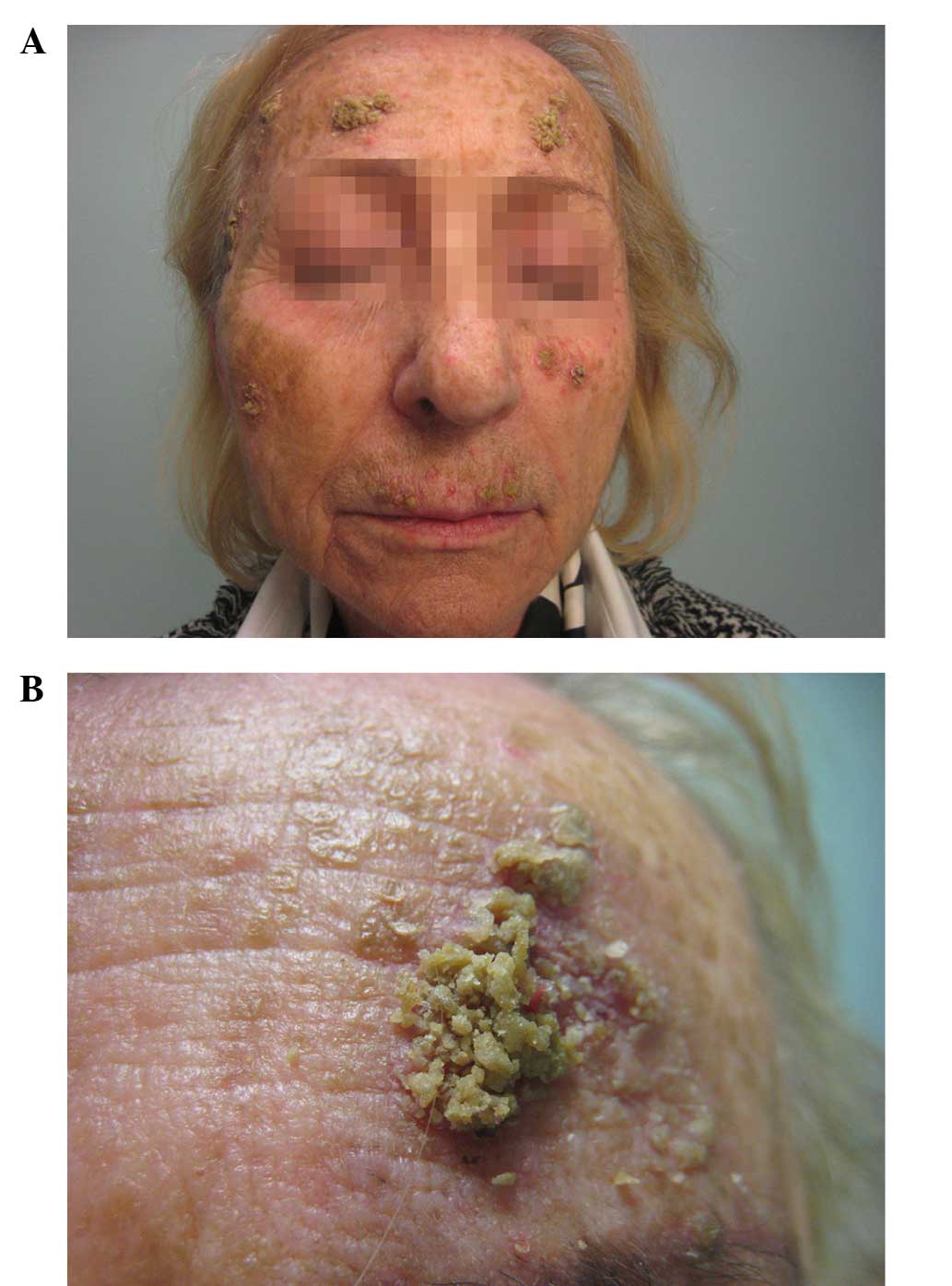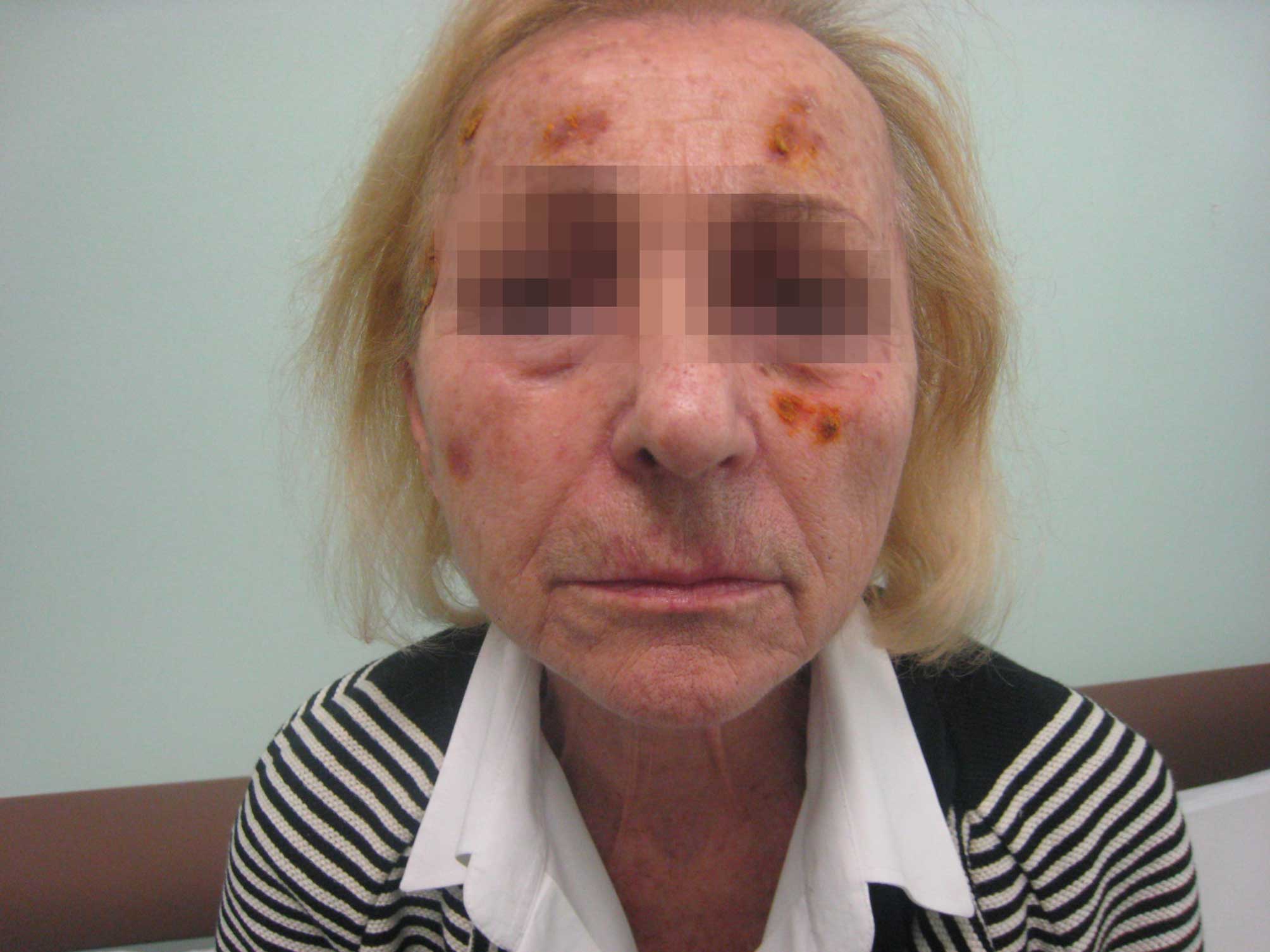|
1
|
Wnorowski MA, de Souza A, Chachoua A and
Cohen DE: The management of EGFR inhibitor adverse events: A case
series and treatment paradigm. Int J Dermatol. 51:223–232. 2012.
View Article : Google Scholar : PubMed/NCBI
|
|
2
|
Ocvirk J, Heeger S, McCloud P and Hofheinz
RD: A review of the treatment options for skin rash induced by EGFR
targeted therapies: Evidence from randomized clinical trials and
meta-analysis. Radiol Oncol. 47:166–175. 2013. View Article : Google Scholar : PubMed/NCBI
|
|
3
|
Luo M and Fu LW: Redundunt kinase
activation and resistance of EGFR-tyrosine kinase inhibitors. Am J
Cancer Res. 4:608–628. 2014.PubMed/NCBI
|
|
4
|
Ricciardi S, Tomao S and de Marinis F:
Toxicity of targeted therapy in non-small cell lung cancer
management. Clin Lung Cancer. 10:28–35. 2009. View Article : Google Scholar : PubMed/NCBI
|
|
5
|
Peréz-Soler R, Delord JP, Halpern A, Kelly
K, Krueger J, Sureda BM, von Pawel J, Temel J, Siena S, Soulières
D, et al: HER1/EGFR inhibitor-associated rash: Future directions
for management and investigation outcomes from the HER1/EGFR
inhibitor rash management forum. Oncologist. 10:345–356. 2005.
View Article : Google Scholar : PubMed/NCBI
|
|
6
|
Chen AP, Setser A, Anadkat MJ, Cotliar J,
Olsen EA, Garden BC and Lacouture ME: Grading dermatologic adverse
events of cancer treatments: The common terminology criteria for
adverse events version 4.0. J Am Acad Dermatol. 67:1025–1039. 2012.
View Article : Google Scholar : PubMed/NCBI
|
|
7
|
Balagula Y, Rosen ST and Lacouture ME: The
emergence of supportive oncodermatology: The study of dermatologic
adverse events to cancer therapies. J Am Acad Dermatol. 65:624–635.
2011. View Article : Google Scholar : PubMed/NCBI
|
|
8
|
Eames T, Grabein B, Kroth J and
Wololenberg A: Microbiological analysis of epidermal growth factor
receptor inhibitor therapy-associated paronychia. J Eur Acad
Dermatol Venereol. 24:958–960. 2010. View Article : Google Scholar : PubMed/NCBI
|
|
9
|
Rami-Porta R, Crowley JJ and Goldstraw P:
The revised TNM staging system for lung cancer. Ann Thorac
Cardiovasc Surg. 15:4–9. 2009.PubMed/NCBI
|
|
10
|
Ciardello F and Tortora G: EGFR
antagonists in cancer treatment. N Engl J Med. 358:1160–1174. 2008.
View Article : Google Scholar : PubMed/NCBI
|
|
11
|
Liu HB, Wu Y, Lv TF, Yao YW, Xiao YY, Yuan
DM and Song Y: Skin rash could predict the response to EGFR
tyrosine kinase inhibitor and the prognosis for patients with
non-small cell lung cancer: A systematic review and meta-analysis.
PloS One. 8:e551282013. View Article : Google Scholar : PubMed/NCBI
|
|
12
|
Potthoff K, Hofheinz R, Hassel JC,
Volkenandt M, Lordick F, Hartmann JT, Karthaus M, Riess H, Lipp HP,
Hauschild A, et al: Interdisciplinary management of
EGFR-inhibitor-induced skin reactions: A German expert opinion. Ann
Oncol. 22:524–535. 2011. View Article : Google Scholar : PubMed/NCBI
|
|
13
|
Heidary N, Naik H and Burgin S:
Chemotherapeutic agents and the skin: An update. J Am Acad
Dermatol. 58:545–570. 2008. View Article : Google Scholar : PubMed/NCBI
|
|
14
|
Herbst RS, LoRusso PM, Purdom M and Ward
D: Dermatologic side effects associated with gefitinib therapy:
Clinical experience and management. Clin Lung Cancer. 4:366–369.
2003. View Article : Google Scholar : PubMed/NCBI
|
|
15
|
Herbst RS, Maddox AM, Rothenberg ML, Small
EJ, Rubin EH, Baselga J, Rojo F, Hong WK, Swaisland H, Averbuch SD,
et al: Selective oral epidermal growth factor receptor tyrosine
kinase inhibitor ZD1839 is generally well-tolerated and has
activity in non-small-cell lung cancer and other solid tumors:
Results of a phase I trial. J Clin Oncol. 20:3815–3825. 2002.
View Article : Google Scholar : PubMed/NCBI
|
|
16
|
Pastore S, Lulli D and Girolomoni G:
Epidermal growth factor receptor signalling in keratinocyte
biology: Implications for skin toxicity of tyrosine kinase
inhibitors. Arch Toxicol. 88:1189–1203. 2014. View Article : Google Scholar : PubMed/NCBI
|
|
17
|
Chang GC, Yang TY, Chen KC, Yin MC, Wang
RC and Lin YC: Complications of therapy in cancer patients: Case 1.
Paronychia and skin hyperpigmentation induced by gefitinib in
advanced non-small-cell lung cancer. J Clin Oncol. 22:4646–4648.
2004. View Article : Google Scholar : PubMed/NCBI
|
|
18
|
Lacouture ME and Lai SE: The PRIDE
(Papulopustules and/or paronychia, Regulatory abnormalities of hair
growth, Itching, and dryness due to epidermal growth factor
receptor inhibitors) syndrome. Br J Dermatol. 155:852–854. 2006.
View Article : Google Scholar : PubMed/NCBI
|
|
19
|
Madke B, Gole P, Kumar P and Khopkar U:
Dermatological side effects of epidermal growth factor receptor
inhibitors: ‘PRIDE’ complex. Indian J Dermatol. 59:271–274. 2014.
View Article : Google Scholar : PubMed/NCBI
|
|
20
|
Eilers RE Jr, Gandhi M, Patel JD, Mulcahy
MF, Agulnik M, Hensing T and Lacouture ME: Dermatologic infections
in cancer patients treated with epidermal growth factor receptor
inhibitor therapy. J Natl Cancer Inst. 102:47–53. 2010. View Article : Google Scholar : PubMed/NCBI
|
|
21
|
Kurokawa I, Endo K and Hirabayashi M:
Purpuric drug eruption possibly due to gefinitib (Iressa). Int J
Dermatol. 44:167–168. 2005. View Article : Google Scholar : PubMed/NCBI
|
|
22
|
Zorzou MP, Stratigos A, Efstathiou E and
Bamias A: Exacerbation of psoriasis after treatment with an EGFR
tyrosine kinase inhibitor. Acta Derm Venereol. 84:308–309. 2004.
View Article : Google Scholar : PubMed/NCBI
|
|
23
|
Trojan A, Jacky E, Follath F and Dummer R:
Necrolytic migratory erythema (glucagenoma)-like skin lesions
induced by EGF-receptor inhibition. Swiss Med Wkly. 133:22–23.
2003.PubMed/NCBI
|
|
24
|
Murillas R, Larcher F, Conti CJ, Santos M,
Ullrich A and Jorcano JL: Expression of a dominant negative mutant
of epidermal growth factor receptor in the epidermis of transgenic
mice elicits striking alterations in hair follicle development and
skin structure. EMBO J. 14:5216–5223. 1995.PubMed/NCBI
|
|
25
|
Mascia F, Cataisson C, Lee TC, Threadgill
D, Mariani V, Amerio P, Chandrasekhara C, Souto Adeva G, Girolomoni
G, Yuspa SH and Pastore S: EGFR regulates the expression of
granulocyte/macrophage colony-stimulating factor in vitro and in
vivo. J Invest Dermatol. 130:682–693. 2010. View Article : Google Scholar : PubMed/NCBI
|
|
26
|
Yamaki M, Sugiura K, Muro Y, Shimoyama Y
and Tomita Y: Epidermal growth factor receptor tyrosine kinase
inhibitors induce CCL2 and CCL5 via reduction in IL-1R2 in
keratinocytes. Exp Dermatol. 19:730–735. 2010. View Article : Google Scholar : PubMed/NCBI
|
|
27
|
Lichtenberger BM, Gerber PA, Holcmann M,
Buhren BA, Amberg N, Smolle V, Schrumpf H, Boelke E, Ansari P,
Mackenzie C, et al: Epidermal EGFR controls cutaneous host defense
and prevents inflammation. Sci Transl Med. 5:199ra1112013.
View Article : Google Scholar : PubMed/NCBI
|
|
28
|
Mascia F, Lam G, Keith C, Garber C,
Steinberg SM, Kohn E and Yuspa SH: Genetic ablation of epidermal
EGFR reveals the dynamic origin of adverse effects of anti-EGFR
therapy. Sci Transl Med. 5:199ra1102013. View Article : Google Scholar : PubMed/NCBI
|
|
29
|
Scope A, Agero AL, Dusza SW, Myskowski PL,
Lieb JA, Saltz L, Kemeny NE and Halpern AC: Randomized double-blind
trial of prophylactic oral minocycline and topical tazarotene for
cetuximab-associated acne-like eruption. J Clin Oncol.
25:5390–5396. 2007. View Article : Google Scholar : PubMed/NCBI
|
|
30
|
Garrido-Mesa N, Zarzuelo A and Gálvez J:
Mynocicline: Far beyond an antibiotic. Br J Pharmacol. 169:337–352.
2013. View Article : Google Scholar : PubMed/NCBI
|











